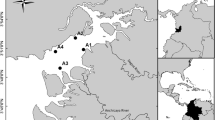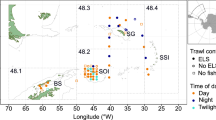Abstract
Fish were collected at regular intervals over 5 yr (February 1977 to December 1981) from ten shallow-water sites located throughout the lower, middle and upper regions of the large Swan Estuary in temperate southwestern Australia. Analysis of the catch data showed that the total number of species and total density of fishes were both influenced to a greater extent by site and season within the estuary than by year. The number of species and density of fishes within the whole system were greatest during the summer and autumn, when salinities and temperatures were at a maximum, and declined with distance from the estuary mouth. This reflects the trends shown by marine species, which comprise many species that occur only occasionally in the estuary (marine stragglers) and others which enter estuaries regularly and in considerable numbers (marine estuarine-opportunists). The density of marine estuarine-opportunists was also correlated with temperature, reflecting the tendency for the species of this category to congregate in the shallows during the summer and autumn. The similar seasonal aggregations of the single anadromous species and representatives of species that complete their whole life cycle in the estuary were frequently related to spawning. The density of the estuarine category was correlated neither with salinity nor distance from the estuary mouth. The number of estuarine species was also not correlated with distance from the estuary mouth. The density of freshwater species was inversely correlated with salinity and positively correlated with distance from the estuary mouth. The composition of the fish fauna changed progressively through the estuary, with that of the lower estuary being the most discrete. The composition also changed seasonally, particularly in the upper estuary where, during the winter and spring, the volume of freshwater discharge increased greatly and as a consequence the salinity declined markedly. The species diagnostic of the lower estuary were generally marine estuarine-opportunists, whereas those of the upper estuary typically belonged to either the estuarine or anadromous categories. The marine estuarine-opportunistMugil cephalus was, however, also one of the diagnostic species in the upper estuary during the winter and spring.
Similar content being viewed by others
Literature cited
Allen, L. G. (1982). Seasonal abundance, composition and productivity of the littoral fish assemblage in upper Newport Bay, California. Fish. Bull. U.S. 80: 769–790
Bell, J. D., Steffe, A. S., Westoby, M. (1988). Location of seagrass beds in estuaries: effects on associated fish and decapods. J. exp. Biol. Ecol. 122: 127–146
Blaber, S. J. M. (1985). The ecology of fishes of estuaries and lagoons of the Indo-Pacific with particular reference to southeast Africa. In: Yáñez-Arancibia, A. (ed.) Fish community ecology in estuaries and coastal lagoons. Universidad Nacional Autonoma de Mexico, Mexico City, p. 247–266. (ISBN 968-837-618-3)
Blaber, S. J. M. (1987). Factors affecting recruitment and survival of mugilids in estuaries and coastal waters of southeastern Africa. Am. Fish. Soc. Symp. 1: 507–518
Blaber, S. J. M., Blaber, T. G. (1980). Factors affecting the distribution of juvenile estuarine and inshore fish. J. Fish Biol 17: 143–162
Chrystal, P. J., Potter, I. C., Loneragan, N. R., Holt, C. P. (1985). Age structure, growth rates, movement patterns and feeding in an estuarine population of the cardinalfishApogon rueppellii. Mar. Biol. 85: 185–197
Chubb, C. F., Potter, I. C. (1984). The reproductive biology and estuarine movements of the gizzard shad,Nematalosa vlaminghi (Munro). J. Fish Biol. 25: 527–543
Chubb, C. F., Potter, I. C. (1986). Age, growth and condition of the Perth herring,Nematalosa vlaminghi (Munro) (Dorosomatinae) in the Swan Estuary, south-western Australia. Aust. J. mar. Freshwat. Res. 37: 105–112
Chubb, C. F., Potter, I. C., Grant, C. J., Lenanton, R. C., Wallace, J. (1981). The age structure, growth rates and movements of sea mullet,Mugil cephalus L., and yellow-eye mullet,Aldrichetta forsteri (Valenciennes), in the Swan-Avon river system. Aust. J. mar. Freshwat. Res. 32: 605–628
Claridge, P. N., Potter, I. C., Hardisty, M. W. (1986). Seasonal changes in movements, abundance, size composition and diversity of the fish fauna of the Severn Estuary. J. mar. biol. Ass. U.K. 66: 229–258
Dando, P. R. (1984). Reproduction in estuarine fish. In: Potts, G. W., Wootton, R. J. (eds.) Fish reproduction strategies and tactics. Academic Press, London, p. 155–170
Day, J. H., Blaber, S. J. M., Wallace J. H. (1981). Estuarine fishes. In: Day, J. H. (ed.) Estuarine ecology with particular reference to Southern Africa. Balkema, Rotterdam, p. 197–221
Gauch, H. G. Jr. (1982a). Magnetic tape copy of the Cornell Ecology Programs Series. Ecology and Systematics, Cornell University, Ithaca, New York
Gauch, H. G. Jr. (1982b). Multivariate analysis in community ecology. Cambridge University Press, Cambridge
Gill, H. S., Miller, P. J. (1990). A new genus and species of goby from the Swan Estuary, Western Australia, with a redescription of the genusFavonigobius Whitley, 1930. Rec. West. Aust. Mus. 14: 503–525
Gunter, G. (1961). Some relations of estuarine organisms to salinity. Limnol. Oceanogr. 6: 182–190
Haedrich, R. L. (1983). Estuarine fishes. In: Ketchum, B. H. (ed.) Ecosystems of the world. 26: Estuaries and enclosed seas. Elsevier Scientific Publishing Co., Oxford, p. 183–207
Hill, M. O. (1979a). TWINSPAN: a FORTRAN program for arranging multivariate data in an ordered two-way table by classification of the individuals and the attributes. Ecology and Systematics, Cornell University, Ithaca, New York
Hill, M. O. (1979b). DECORANA: a FORTRAN program for detrended correspondence analysis and reciprocal averaging. Ecology and Systematics, Cornell University, Ithaca, New York
Hill, M. O., Gauch, H. G. (1980). Detrended correspondence analysis, an improved ordination technique. Vegtatio 42: 47–58
Hoff, J. G., Ibara, R. M. (1977). Factors affecting the seasonal abundance, composition and diversity of fishes in a southeastern New England Estuary. Estuar. cstl mar. Sci 5: 665–678
Kinne, O. (1964). The effects of temperature and salinity on marine and brackish water animals. II. Salinity and temperature — salinity combinations. Oceanogr. mar. Biol. A. Rev. 2: 281–339
Lenanton, R. C. J., Potter, I. C. (1987). Contribution of estuaries to commercial fisheries in temperate Western Australia and the concept of estuarine dependence. Estuaries 10: 28–35
Lenanton, R. C. J., Potter, I. C., Loneragan, N. R., Chrystal, P. J. (1984). Age structure and changes in abundance of three important teleosts in a eutrophic estuary. J. Zool., Lond. 203: 311–327
Loneragan, N. R., Potter, I. C., Lenanton, R. C. J. (1989). Influence of site, season and year on contributions made by marine, estuarine, diadromous and freshwater species to the fish fauna of a temperate Australian estuary. Mar. Biol 103: 461–479
Loneragan, N. R., Potter, I. C., Lenanton, R. C. J., Caputi, N. (1986). Spatial and seasonal differences in the fish fauna in the shallows of a large Australian estuary. Mar. Biol. 92: 575–586
Loneragan, N. R., Potter, I. C., Lenanton, R. C. J., Caputi, N. (1987). Influence of environmental variables on the fish fauna of the deeper waters of a large Australian estuary. Mar. Biol 94: 631–641
Nel, S. A., Potter, I. C., Loneragan, N. R. (1985). The biology of the catfishCnidoglanis macrocephalus (Plotosidae), in an Australian estuary. Estuar., cstl Shelf Sci. 21: 895–909
Potter, I. C., Beckley, L. E., Whitfield, A. K., Lenanton, R. C. J. (1990). The roles played by estuaries in the life cycles of fishes in temperate western Australia and southern Africa. In: Bruton, M. N. (ed.) Alternative life history styles of fishes. Kluwer Academic Press, Dordrecht (in press)
Potter, I. C., Cheal, A. J., Loneragan, N. R. (1988). Protracted estuarine phase in the life cycle of the marine pufferfishTorquigener pleurogramma. Mar. Biol. 98: 317–329
Potter, I. C., Claridge, P. N., Warwick, R. M. (1986). Consistency of seasonal changes in an estuarine fish assemblage. Mar. Ecol. Prog. Ser. 32: 217–228
Potter, I. C., Loneragan, N. R., Lenanton, R. C. J., Chrystal, P. J., Grant, C. J. (1983). Abundance, distribution and age structure of fish populations in a Western Australian estuary. J. Zool., Lond. 200: 21–50
Prince, J. D., Potter, I. C. (1983). Life cycle duration, growth and spawning times in five species of Atherinidae (Teleostei) in a Western Australian estuary. Aust. J. mar. Freshwat. Res. 34: 287–301
Prince, J. D., Potter, I. C., Lenanton, R. C. J., Loneragan, N. R. (1982). Segregation and feeding of atherinid species (Teleostei) in south-western Australian estuaries. Aust. J. mar. Freshwat. Res. 33: 865–880
Quinn, R. J. (1980). Analysis of temporal changes in fish assemblages in Serpentine Creek, Queensland. Envir. Biol. Fish. 5: 117–133
Thomson, J. M. (1957). The penetration of estuarine fish into freshwater in the Albert River. Proc. R. Soc. Qd 68: 17–20
Underwood, A. J. (1981). Techniques of analysis of variance in experimental marine biology and ecology. Oceanogr. mar. Biol. A. Rev. 19: 513–605
Warburton, K. (1978). Community structure, abundance and diversity of fish in a Mexican coastal lagoon system. Estuar. cstl mar. Sci. 7: 497–519
Weinstein, M. P., Weiss, S. L., Walters, M. F. (1980). Multiple determinants of community structure in shallow marsh habitats, Cape Fear River estuary, North Carolina, USA. Mar. Biol. 58: 227–243
Whitfield, A. K., Blaber, S. J. M., Cyrus, D. P. (1981). Salinity ranges of some southern African fish species occurring in estuaries. S. Afr. J. Zool. 16: 151–155
Yáñez-Arancibia, A., Linares, F. A., Day, J. W. (1980). Fish community structure and function in Terminos Lagoon, a tropical estuary in the southern Gulf of Mexico. In: Estuarine perspectives. Kennedy, V. S. (ed.). Academic Press, New York, p. 456–488
Young, P. C. (1981). Temporal changes in the vagile epibenthic fauna of two seagrass meadows (Zostera capricorni andPosidonia australis). Mar. Ecol. Prog. Ser. 5: 91–102
Author information
Authors and Affiliations
Additional information
Communicated by G.F. Humphrey, Sydney
Please address all correspondence and requests for reprints to I. C. Potter at Murdoch University
Rights and permissions
About this article
Cite this article
Loneragan, N.R., Potter, I.C. Factors influencing community structure and distribution of different life-cycle categories of fishes in shallow waters of a large Australian estuary. Mar. Biol. 106, 25–37 (1990). https://doi.org/10.1007/BF02114671
Accepted:
Issue Date:
DOI: https://doi.org/10.1007/BF02114671




